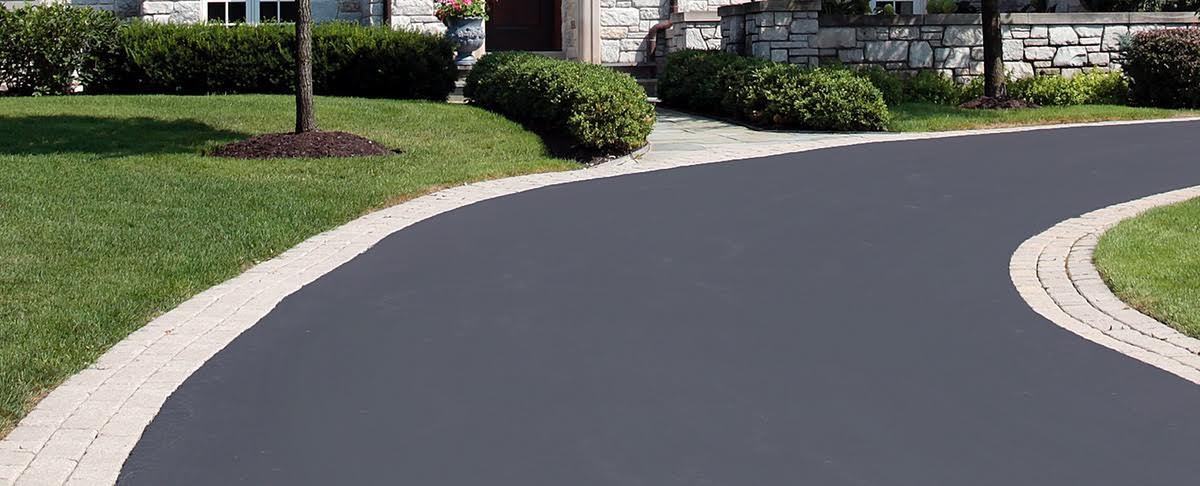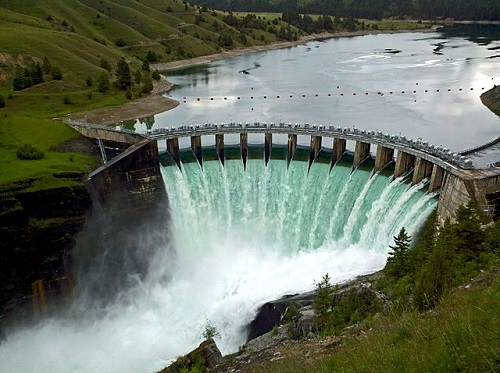Asphalt
Asphalt is a sticky, black and highly viscous liquid or semi-solid that is present in most crude petroleums.It may be found in natural deposits or may be a refined product, and is classed as a pitch. Before the 20th century, the term asphaltum was also used.
For naturally occurring bituminous sands used for petroleum production, see Oil sands.
The primary use (70%) of asphalt is in road construction, where it is used as the glue or binder mixed with aggregate particles to create asphalt concrete.
Its other main uses are for bituminous waterproofing products, including production of roofing felt and for sealing flat roofs.
Naturally occurring asphalt is sometimes specified by the term "crude bitumen".
Its viscosity is similar to that of cold molasses while the material obtained from the fractional distillation of crude oil boiling at 525 °C (977 °F) is sometimes referred to as "refined bitumen".
1. Normal Composition:
The components of asphalt include four main classes of compounds:
Naphthene aromatics (naphthalene), consisting of partially hydrogenated polycyclic aromatic compounds
Polar aromatics, consisting of high molecular weight phenols and carboxylic acids produced by partial oxidation of the material
Saturated hydrocarbons; the percentage of saturated compounds in asphalt correlates with its softening point
Asphaltenes, consisting of high molecular weight phenols and heterocyclic compounds
The naphthene aromatics and polar aromatics are typically the majority components.
Most natural bitumens also contain organosulfur compounds, resulting in an overall sulfur content of up to 4%. Nickel and vanadium are found at <10 parts per million, as is typical of some petroleum.The substance is soluble in carbon disulfide.
It is commonly modelled as a colloid, with asphaltenes as the dispersed phase and maltenes as the continuous phase.
"It is almost impossible to separate and identify all the different molecules of asphalt, because the number of molecules with different chemical structure is extremely large".
Most natural bitumens also contain organosulfur compounds, resulting in an overall sulfur content of up to 4%. Nickel and vanadium are found at <10 parts per million, as is typical of some petroleum.The substance is soluble in carbon disulfide.
It is commonly modelled as a colloid, with asphaltenes as the dispersed phase and maltenes as the continuous phase.
"It is almost impossible to separate and identify all the different molecules of asphalt, because the number of molecules with different chemical structure is extremely large".
Asphalt may be confused with coal tar, which is a visually similar black, thermoplastic material produced by the destructive distillation of coal.
Additives, mixtures and contaminants:
Additives, mixtures and contaminants:
For economic and other reasons, asphalt is sometimes sold combined with other materials, often without being labeled as anything other than simply "asphalt"
Of particular note, in the 21st century, is the use of re-refined engine oil bottoms -- "REOB" or "REOBs"—the residue of recycled autmotive engine oil, collected from the bottoms of re-refining vacuum distillation towers. It contains the various non-refined elements and compounds in recycled engine oil, leftover from the re-refining process—both additives to the original oil, and materials accumulating from its circulation in the engine (typically iron and copper).
Some research has indicated a correlation between this contamination of asphalt and poorer-performing pavement.
Some research has indicated a correlation between this contamination of asphalt and poorer-performing pavement.
Occurrence:
The majority of asphalt used commercially is obtained from petroleum. Nonetheless, large amounts of asphalt occur in concentrated form in nature. Naturally occurring deposits of bitumen are formed from the remains of ancient, microscopic algae (diatoms) and other once-living things. These remains were deposited in the mud on the bottom of the ocean or lake where the organisms lived. Under the heat (above 50 °C) and pressure of burial deep in the earth, the remains were transformed into materials such as bitumen, kerogen, or petroleum.Bitumen may occur in hydrothermal veins. An example of this is within the Uinta Basin of Utah, in the US, where there is a swarm of laterally and vertically extensive veins composed of a solid hydrocarbon termed Gilsonite. These veins formed by the polymerization and solidification of hydrocarbons that were mobilized from the deeper oil shales of the Green River Formation during burial and diagenesis.
2. Modern use:
Global use
The vast majority of refined asphalt is used in construction: primarily as a constituent of products used in paving and roofing applications.
According to the requirements of the end use, asphalt is produced to specification. This is achieved either by refining or blending.
It is estimated that the current world use of asphalt is approximately 102 million tonnes per year.
Approximately 85% of all the asphalt produced is used as the binder in asphalt concrete for roads.
It is also used in other paved areas such as airport runways, car parks and footways.
Typically, the production of asphalt concrete involves mixing fine and coarse aggregates such as sand, gravel and crushed rock with asphalt, which acts as the binding agent.
Other materials, such as recycled polymers (e.g., rubber tyres), may be added to the asphalt to modify its properties according to the application for which the asphalt is ultimately intended.
A further 10% of global asphalt production is used in roofing applications, where its waterproofing qualities are invaluable.
The remaining 5% of asphalt is used mainly for sealing and insulating purposes in a variety of building materials, such as pipe coatings, carpet tile backing and paint.
Asphalt is applied in the construction and maintenance of many structures, systems, and components,
such as the following:
Highways
Airport runways
Foot ways and pedestrian ways
Car parks
Racetracks
Tennis courts
Roofing
Damp proofing
Dams
Reservoir and pool linings
Sound proofing This is just some code.
Pipe coatings
Cable coatings
Paints
Building water proofing
Tile underlying waterproofing
Newspaper ink production
and many other applications
All Kind Of Asphalt
Rolled asphalt concrete:
The largest use of asphalt is for making asphalt concrete for road surfacesAsphalt concrete pavement mixes are typically composed of 5% asphalt cement and 95% aggregates (stone, sand, and gravel).
Due to its highly viscous nature, asphalt cement must be heated so it can be mixed with the aggregates at the asphalt mixing facility.
The temperature required varies depending upon characteristics of the asphalt and the aggregates, but warm-mix asphalt technologies allow producers to reduce the temperature required.
The weight of an asphalt pavement depends upon the aggregate type, the asphalt, and the air void content.
When maintenance is performed on asphalt pavements, such as milling to remove a worn or damaged surface, the removed material can be returned to a facility for processing into new pavement mixtures. The asphalt in the removed material can be reactivated and put back to use in new pavement mixes.
With some 95% of paved roads being constructed of or surfaced with asphalt, a substantial amount of asphalt pavement material is reclaimed each year.
According to industry surveys conducted annually by the Federal Highway Administration and the National Asphalt Pavement Association, more than 99% of the asphalt removed each year from road surfaces during widening and resurfacing projects is reused as part of new pavements, roadbeds, shoulders and embankments.
Asphalt concrete paving is widely used in airports around the world. Due to the sturdiness and ability to be repaired quickly, it is widely used for runways.
Mastic asphalt:
Further information: Fiber mastic asphaltMastic asphalt is a type of asphalt that differs from a dense graded asphalt (asphalt concrete) in that it has a higher asphalt (binder) content, typically about 7-10% of the total aggregate mix, as opposed to rolled asphalt concrete, which has only around 5% asphalt. This thermoplastic substance is widely used in the building industry for waterproofing flat roofs and tanking underground. The mastic asphalt is heated to 210 ° C (410 ° F) and spread in layers to form an impervious barrier about 20 millimeters (0.8 inches) thick.
Asphalt emulsion:
A number of technologies allow asphalt to be mixed at much lower temperatures. These involve mixing with petroleum solvents to form "cutbacks" with reduced melting point or mixing with water to turn the asphalt into an emulsion. Asphalt emulsions contain up to 70% asphalt and typically less than 1.5% chemical additives. There are two main types of emulsions with different affinity for aggregates, cationic and anionic. Asphalt emulsions are used in a wide variety of applications. Chip seal involves spraying the road surface with asphalt emulsion followed by a layer of crushed rock, gravel or crushed slag. Slurry seal involves the creation of a mixture of asphalt emulsion and fine crushed aggregate that is spread on the surface of a road. Cold-mixed asphalt can also be made from asphalt emulsion to create pavements similar to hot-mixed asphalt, several inches in depth, and asphalt emulsions are also blended into recycled hot-mix asphalt to create low-cost pavements.Synthetic crude oil:
See also: Petroleum productionSynthetic crude oil, also known as syn crude, is the output from a bitumen up grader facility used in connection with oil sand production. Bituminous sands are mined using enormous (100 ton capacity) power shovels and loaded into even larger (400 ton capacity) dump trucks for movement to an upgrading facility. The process used to extract the bitumen from the sand is a hot water process originally. After extraction from the sand, the bitumen is fed into a bitumen up grader which converts it into a light crude oil equivalent. This synthetic substance is fluid enough to be transferred through conventional oil pipelines and can be fed into conventional oil refineries without any further treatment.
Other uses:
Roofing shingles account for most of the remaining asphalt consumption. Other uses include cattle sprays, fence-post treatments, and waterproofing for fabrics. Asphalt is used to make Japan black, a lacquer known especially for its use on iron and steel, and it is also used in paint and marker inks by some exterior paint supply companies to increase the weather resistance and permanence of the paint or ink, and to make the color darker. Asphalt is also used to seal some alkaline batteries during the manufacturing process.
Prefabricated Bituminous Geo Membrane
Moisture insulation types are prefabricated in isolation tanks of water, dams, channels and water supply networks, the application of different types of Prefabricated Bituminous Geo Membrane based on the type of application and the lifetime of the desired structure, consistent with the terms of the drinking water and agricultural water company Chemical Mine World in the production and presentation.
The use of these products in the structures, while reducing waste water and reduce the phenomenon went due to water penetration into the soil or the seabed of adjacent structures, reducing the risks of water contamination as well.







